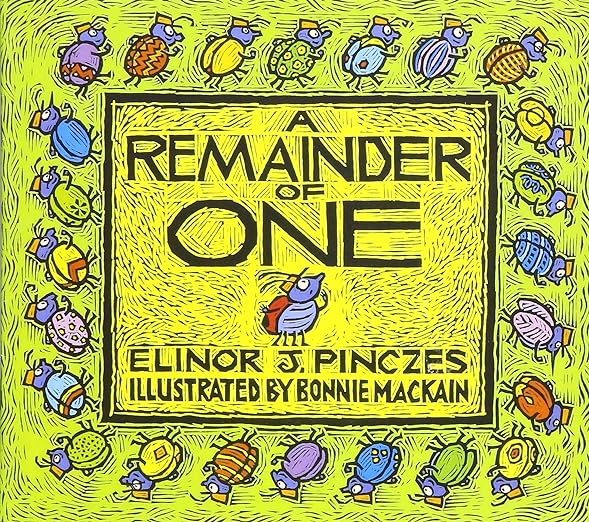This post contains affiliate links. If you purchase through the links we earn some commission at no additional cost to you. These funds would support the running of this site. No obligations though!
Need an easy-to-adapt idea to teach the concept of remainder in division to the young ones? We have just the story to suggest! Read on to find out about what the story offers and some activities that can complement it in your teaching.

A Remainder of One
Author: Elinor J. Pinczes
Illustrator: Bonnie MacKain
Publisher: Clarion Books
First published: August 2002
Buy on Amazon.com or Amazon.sg
List of Contents
- Summary
- Our Review
- Our Favorite Line
- Math Learning Involved
- Recommended Grade Level
- Relevant Math Language
- Prior Knowledge
- Learning Activities
Summary
A rhyming tale of bugs marching and having the last remaining bug Joe feeling quite out-of-place. The squadron of 25 divides themselves into 2 lines, 3 lines, 4 lines and finally 5. With several attempts, he manages to fit in!
Our Review
This is a must-read when it comes to introducing the notion of a remainder resulting from division! Children will feel for Joe’s plight. Though the poetic lines may require some effort in deciphering the meanings, the overall storyline is easy for children to catch on. The choice of words can lend well to a vocabulary lesson on synonyms. The illustrations are delightful as well – with nuggets of surprise e.g. how the colors of the squadron line up in the final formation. The story can also inspire perseverance when solving a problem.
Our Favorite Line
“The story of Joe might well explain what happens to numbers when they must remain after division…”
A Remainder of One
Math Learning Involved
- Division with remainder
Recommended Grade Level
Grades 2 to 3
Children younger than Grade 2 might not appreciate the story mathematically, while those in Grade 4 and above might be bored by the plot.
*Note that this is just a recommendation, and may vary depending on your learners’ profile and your topical content to cover.
Relevant Math Language
- Division
- Divided by ___
- _______ lines of __________
- Remainder (of one)
Prior Knowledge
(be sure to do a quick review prior to reading!):
- Basic multiplication tables facts (specifically, 2s, 3s, 4s and 5s)
- Concept of division (without remainder)
- (good to have) Odd and even numbers
- (good to have) Factors
Learning Activities
What are some investigative tasks, experiences and discussion questions that can accompany the book?
Before Reading
- What do you think this story is about?
- What do you think ‘remainder’ means?
After hearing their inputs, get them to keep this question at the back of their minds as you read the book together.
While Reading
- Provide little manipulatives (e.g. cubes or clips or anything that is small and identical). Get the kids to create the formations of the squadron along with the story.
- With each formation of the squadron, write down the division equation on the board e.g. 25 ÷ 2 = 12 R 1. You don’t have to talk about what R stands for or to elaborate anything. In fact, continue with the story to maintain the momentum.
- After Sergeant Steven tells Joe to stand aside for the first time, ask, “What can Joe do?”
After Reading
- What does R in my division equations mean?
Remainder! Feels like this is asking the obvious, isn’t it? But getting them to connect the meaning themselves, makes it a tad easier for them to remember to write R (and not anything else) next time!
- Look at my equations again. What’s changed, and what remained constant? What happens as the divisor increases? Why?
- If all these divisions of 25 gave a remainder of 1, what does that say about 24?
- What other numbers have a remainder of one? (The first kid who can point out that this depends on the divisor as well, deserves praise!)
- Can I have a remainder, greater than one? Like, remainder of five?
- Can I have a remainder of one when I divide something by one?
- What other numbers give a remainder of one when divided by two? What do you notice about them?
- What is the greatest possible remainder I can get?
- What does the word ‘even’ mean in the story? Does it mean the same as in ‘odd and even numbers’?
- Using the same manipulatives, give a number (e.g 20 or 36) and ask them to put the items into neat rows without remainder. You can also get them to jot down division equations as they investigate.
You might see students who approach the problem systematically – first dividing by two, then three, then four and so on. These students could be taking reference to the storyline, which is evidence that the story has helped to scaffold their thinking in this problem!
You might also have students who jump to multiplication tables that they recall the number falls in. This is a good opportunity to introduce the term ‘factors’ to them and illustrating how they have used this concept.

A Remainder of One
Author: Elinor J. Pinczes
Illustrator: Bonnie MacKain
Publisher: Clarion Books
First published: August 2002
Buy on Amazon.com or Amazon.sg
Used this book in your math class to teach division with remainder? Let us know how it went here or drop a comment below!
Find out more about maximizing the values of books in Math lessons.
Leave a Reply